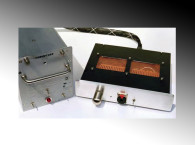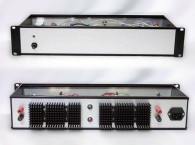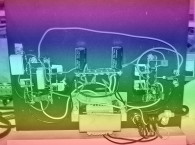- on Project Articles
- Article
Portable Headphone Amplifiers
Headphone amps, just like speaker amps, are available in many varieties: tube-based, semiconductor-based, and mixtures of both technologies. Most mid-fi CD players, receivers, and amps also offer headphone outputs. And, of course, all portable Walkman-type CD players, cassette players, and radios use headphones.
The most problematic of these is the last group, because they are operating from batteries. Of course, nothing is wrong with batteries per se, except for the amount of voltage/current available for the headphone amp.
Consider for a moment the voltage/current requirements for the two types of headphones described previously. The 40Ω unit required 3.2V RMS to generate 124dB SPL. Since we are talking about sine waves here, the 3.2V RMS is equal to 3.2 x 2.82V peak-to-peak, i.e., 9.024V for the amplifier. And this is a theoretical value.
Practical amplifiers that operate with a 9V supply cannot deliver 9V peak-to-peak audio signal, because most audio amps are not capable of working "rail-to-rail," i.e., from zero to 9V. In addition, the 9V battery would need to deliver 80mA for just the audio amp, not taking into consideration the rest of the electronics.
And this is not the end of the story. The Walkman-type devices are usually operating with two 1.5V batteries, for a supply of 3V total. Assuming that the audio amp would be able to work "rail-to-rail," the equivalent audio signal would be 3/2.82 = 1.06V RMS, and you could generate a maximum current of:
I = 1.06/40Ω = 26.5mA
This would give a maximum power of:
P = U × I = 1.06V x 26.5mA = 28.1mW
And SPL difference would be:
SPL.diff. = 10 log 28.1 = 14.5dB
And the maximum SPL: 100dB +14.5dB = 114.5dB, which is actually "only" 10dB less than the maximum. However, remember that in most cases the audio signal would be less than the one calculated, or the amp would already be clipping at a lower value. In a 32Ω headphone with 100dB SPL for 1mW input, the maximum power would be 35mW and the maximum SPL would be 115dB!
Real-life ICs, made specifically for low-voltage operation, will usually deliver less than this. Look up the National LM4911, which is a stereo headphone amp -- it delivers 25mW into 32Ω at 1% THD from a 3V battery (12mW from 2.4V). This means that just a bit over 80% of the battery voltage is "converted" into audio! I bet most of the Walkman-type devices don't deliver much more than 10−15mW of "clean" audio!
What would happen if you connected a 600Ω headphone to this amp? The maximum current would be: 1.06/600 = 1.77mA, the maximum power: 1.06V x 1.77mA = 1.88mW. The SPL difference is:
10 log 1.88 = 2.74dB and the maximum SPL is 98dB + 2.74dB = 100.74dB.
Obviously, 600Ω headphones are less suited for this kind of application. For amps with low supply voltage, you need to use low-impedance headphones, assuming, of course, that the amp can deliver the necessary current.
Headphone amps operating from ±9V batteries fare much better in terms of maximum power. Assuming an 80% ratio between battery voltage and audio signal, such an amp could deliver over 600mW into a 40Ω headphone. Of course, the battery would also need to deliver the necessary current (over 120mA!), and the question is how long it would be able to do that? The same amp would manage only about 40mW into a 600Ω headphone, so even an amp working with ± 9V power supply cannot cover the whole impedance range.
In addition to the problem of available power, most of the low-voltage, battery-operated headphone amps are working with very low bias current to save battery life. This means in most cases Class-B operation. Now it's well known that Class-B is far from ideal in terms of sound quality due to crossover distortion, but there is really not much you can do when the amp must be portable and operate from low-voltage batteries. Still, there are many people listening to portable devices, so it cannot be all that bad!
Headphone amps, just like speaker amps, are available in many varieties: tube-based, semiconductor-based, and mixtures of both technologies. Most mid-fi CD players, receivers, and amps also offer headphone outputs. And, of course, all portable Walkman-type CD players, cassette players, and radios use headphones.
The most problematic of these is the last group, because they are operating from batteries. Of course, nothing is wrong with batteries per se, except for the amount of voltage/current available for the headphone amp.
Consider for a moment the voltage/current requirements for the two types of headphones described previously. The 40Ω unit required 3.2V RMS to generate 124dB SPL. Since we are talking about sine waves here, the 3.2V RMS is equal to 3.2 x 2.82V peak-to-peak, i.e., 9.024V for the amplifier. And this is a theoretical value.
Practical amplifiers that operate with a 9V supply cannot deliver 9V peak-to-peak audio signal, because most audio amps are not capable of working "rail-to-rail," i.e., from zero to 9V. In addition, the 9V battery would need to deliver 80mA for just the audio amp, not taking into consideration the rest of the electronics.
And this is not the end of the story. The Walkman-type devices are usually operating with two 1.5V batteries, for a supply of 3V total. Assuming that the audio amp would be able to work "rail-to-rail," the equivalent audio signal would be 3/2.82 = 1.06V RMS, and you could generate a maximum current of:
I = 1.06/40Ω = 26.5mA
This would give a maximum power of:
P = U × I = 1.06V x 26.5mA = 28.1mW
And SPL difference would be:
SPL.diff. = 10 log 28.1 = 14.5dB
And the maximum SPL: 100dB +14.5dB = 114.5dB, which is actually "only" 10dB less than the maximum. However, remember that in most cases the audio signal would be less than the one calculated, or the amp would already be clipping at a lower value. In a 32Ω headphone with 100dB SPL for 1mW input, the maximum power would be 35mW and the maximum SPL would be 115dB!
Real-life ICs, made specifically for low-voltage operation, will usually deliver less than this. Look up the National LM4911, which is a stereo headphone amp -- it delivers 25mW into 32Ω at 1% THD from a 3V battery (12mW from 2.4V). This means that just a bit over 80% of the battery voltage is "converted" into audio! I bet most of the Walkman-type devices don't deliver much more than 10−15mW of "clean" audio!
What would happen if you connected a 600Ω headphone to this amp? The maximum current would be: 1.06/600 = 1.77mA, the maximum power: 1.06V x 1.77mA = 1.88mW. The SPL difference is:
10 log 1.88 = 2.74dB and the maximum SPL is 98dB + 2.74dB = 100.74dB.
Obviously, 600Ω headphones are less suited for this kind of application. For amps with low supply voltage, you need to use low-impedance headphones, assuming, of course, that the amp can deliver the necessary current.
Headphone amps operating from ±9V batteries fare much better in terms of maximum power. Assuming an 80% ratio between battery voltage and audio signal, such an amp could deliver over 600mW into a 40Ω headphone. Of course, the battery would also need to deliver the necessary current (over 120mA!), and the question is how long it would be able to do that? The same amp would manage only about 40mW into a 600Ω headphone, so even an amp working with ± 9V power supply cannot cover the whole impedance range.
In addition to the problem of available power, most of the low-voltage, battery-operated headphone amps are working with very low bias current to save battery life. This means in most cases Class-B operation. Now it's well known that Class-B is far from ideal in terms of sound quality due to crossover distortion, but there is really not much you can do when the amp must be portable and operate from low-voltage batteries. Still, there are many people listening to portable devices, so it cannot be all that bad!





